Canon C500, C500 PL User Manual
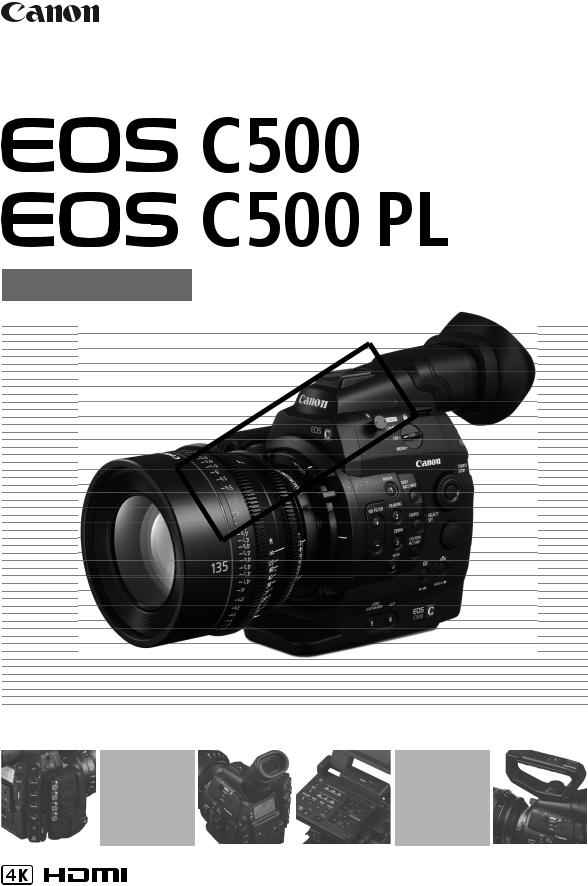
PUB. DIE-0426-000
Digital Cinema Camera
Instruction Manual
COPY
The warranty information for Australia and New Zealand is at the end of this Instruction Manual.

Important Usage Instructions
WARNING
2TO REDUCE THE RISK OF FIRE OR ELECTRIC SHOCK, DO NOT EXPOSE THIS PRODUCT TO RAIN OR MOISTURE.
WARNING
TO REDUCE THE RISK OF ELECTRIC SHOCK, DO NOT EXPOSE THIS PRODUCT TO DRIPPING OR SPLASHING.
WARNING
TO REDUCE THE RISK OF ELECTRIC SHOCK AND TO REDUCE ANNOYING INTERFERENCE, USE THE RECOMMENDED ACCESSORIES ONLY.
COPYRIGHT WARNING:
Unauthorized recording of copyrighted materials may infringe on the rights of copyright owners and be contrary to copyright laws.
FCC NOTICE |
the equipment off and on, the user is |
|
Digital Cinema Camera, EOS C500 / EOS C500 |
encouraged to try to correct the interference by |
|
PL Systems. |
one or more of the following measures: |
|
This device complies with Part 15 of the FCC |
• Reorient or relocate the receiving antenna. |
|
Rules. Operation is subject to the following two |
||
• Increase the separation between the |
||
conditions: (1) This device may not cause |
||
equipment and receiver. |
||
harmful interference, and (2) this device must |
||
• Connect the equipment into an outlet on a |
||
accept any interference received, including |
||
circuit different from that to which the receiver |
||
interference that may cause undesired |
||
is connected. |
||
operation. |
||
• Consult the dealer or an experienced radio/TV |
||
|
||
Note: This equipment has been tested and |
technician for help. |
|
found to comply with the limits for class B digital |
Use of shielded cable is required to comply with |
|
device, pursuant to Part 15 of the FCC Rules. |
||
class B limits in Subpart B of Part 15 of FCC |
||
|
||
These limits are designed to provideCOPYreasonable |
||
protection against harmful interference in a |
Rules. |
|
Do not make any changes or modifications to |
||
residential installation. This equipment |
||
the equipment unless otherwise specified in the |
||
generates, uses and can radiate radio frequency |
||
manual. |
||
energy and, if not installed and use in |
||
If such changes or modifications should be |
||
accordance with the instructions, may cause |
||
made, you could be required to stop operation |
||
harmful interference to radio communications. |
||
of the equipment. |
||
However, there is no guarantee that interference |
||
|
||
will not occur in a particular installation. If this |
Canon U.S.A., Inc. |
|
equipment does cause harmful interference to |
One Canon Plaza, Lake Success, |
|
radio or television reception, which can be |
NY 11042, U.S.A. |
|
determined by turning |
Tel No. (516) 328-5600 |
|
|
|
|
The Mains plug is used as the disconnect device. The Mains plug shall remain readily operable to disconnect the plug in case of an accident.
CAUTION:
•Danger of explosion if the wrong type of batteries are attached. Use only the same type of batteries.
•Do not expose batteries or product to excessive heat such as the inside of a car under direct sunlight, fire, etc.
EOS C500 / EOS C500 PL / CA-940 / CG-940 identification plate is located on the bottom.
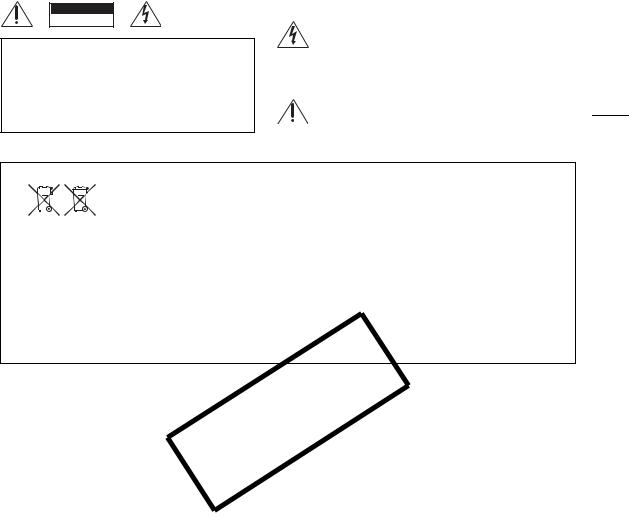
CAUTION
RISK OF ELECTRIC SHOCK
DO NOT OPEN
CAUTION:
TO REDUCE THE RISK OF ELECTRIC SHOCK, DO NOT REMOVE COVER (OR BACK). NO USER-SERVICEABLE PARTS INSIDE. REFER SERVICING TO QUALIFIED SERVICE PERSONNEL.
The lightning flash with arrowhead symbol, within an equilateral triangle, is intended to alert the user to the presence of uninsulated “dangerous voltage” within the product’s enclosure, that may be of sufficient magnitude to constitute a risk of electric shock to persons.
The exclamation point, within an equilateral triangle, is intended to alert the user to the presence of important 3 operating and maintenance (servicing) instructions in
the literature accompanying the product.
European Union (and EEA) only.
These symbols indicate that this product is not to be disposed of with your household waste, according to the WEEE Directive (2002/96/EC), the Battery Directive (2006/66/EC) and/or your national laws implementing those Directives.
 This product should be handed over to a designated collection point, e.g., on an authorized one-for-one basis when you buy a new similar product or to an authorized collection site for recycling waste electrical and electronic equipment (EEE) and batteries and accumulators. Improper handling of this type of waste could have a possible impact on the environment and human health due to potentially hazardous substances that are generally associated with EEE. Your cooperation in the correct disposal of this product will contribute to the effective usage of natural resources.
This product should be handed over to a designated collection point, e.g., on an authorized one-for-one basis when you buy a new similar product or to an authorized collection site for recycling waste electrical and electronic equipment (EEE) and batteries and accumulators. Improper handling of this type of waste could have a possible impact on the environment and human health due to potentially hazardous substances that are generally associated with EEE. Your cooperation in the correct disposal of this product will contribute to the effective usage of natural resources.
For more information about the recycling of this product, please contact your local city office, waste authority, approved scheme or your household waste disposal service or visit www.canon-europe.com/ environment.
(EEA: Norway, Iceland and Liechtenstein)
COPY
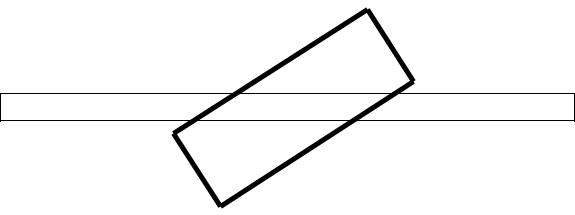
Important Safety Instructions
|
In these safety instructions the word “apparatus” |
A grounding type plug has two blades and a third |
||
4 refers to the Canon Digital Cinema Camera |
grounding prong. The wide blade or the third |
|||
|
EOS C500 / EOS C500 PL and all its accessories. |
prong are provided for your safety. If the provided |
||
|
||||
1. |
Read these instructions. |
plug does not fit into your outlet, consult an |
||
electrician for replacement of the obsolete outlet. |
||||
2. |
Keep these instructions. |
|||
10. Protect the power cord from being walked on or |
||||
3. |
Heed all warnings. |
|||
pinched particularly at plugs, convenience |
||||
4. |
Follow all instructions. |
receptacles, and the point where they exit from |
||
5. |
Do not use this apparatus near water. |
the apparatus. |
||
11. Only use attachments/accessories specified by |
||||
6. |
Clean only with dry cloth. |
|||
the manufacturer. |
||||
7. |
Do not block any ventilation openings. Install in |
|||
12. Unplug this apparatus during lightning storms or |
||||
|
|
accordance with the manufacturer’s instructions. |
||
|
|
when unused for long periods of time. |
||
8. |
Do not install near any heat sources such as |
|||
13. Refer all servicing to qualified service personnel. |
||||
|
|
radiators, heat registers, stoves, or other |
||
|
|
Servicing is required when the apparatus has |
||
|
|
apparatus (including amplifiers) that produce |
||
|
|
been damaged in any way, such as power-supply |
||
|
|
heat. |
||
|
|
cord or plug is damaged, liquid has been spilled |
||
9. |
Do not defeat the safety purpose of the polarized |
|||
or objects have fallen into the apparatus, the |
||||
|
|
or grounding-type plug. A polarized plug has two |
||
|
|
apparatus has been exposed to rain or moisture, |
||
|
|
|
||
•SD and SDHC Logos are trademarksCOPYof SD-3 , LLC.
•CompactFlash is a trademark of SanDisk Corporation.
•The Logo is a trademark of CompactFlash Association.
•Microsoft and Windows are trademarks or registered trademarks of Microsoft Corporation in the United States and/or other countries.
•Apple, Mac OS, Final Cut Pro are trademarks of Apple Inc., registered in the U.S. and other countries.
•Avid, Media Composer and NewsCutter are trademarks or registered trademarks of Avid Technology, Inc. or its subsidiaries in the United States and/or other countries.
•Wi-Fi is a registered trademark of the Wi-Fi Alliance.
•AJA, KONA 3G-SDI are trademarks of AJA Video, Inc. All other trademarks are the property of their respective holders.
•NVIDIA, GeForce and Quadro are trademarks and/or registered trademarks of NVIDIA Corporation in the U.S. and other countries.
•HDMI, the HDMI logo and High-Definition Multimedia Interface are trademarks or registered trademarks of HDMI Licensing LLC in the United States and other countries.
•Other names and products not mentioned above may be trademarks or registered trademarks of their respective companies.
•This device incorporates exFAT technology licensed from Microsoft.
•ANY USE OF THIS PRODUCT OTHER THAN CONSUMER PERSONAL USE IN ANY MANNER THAT COMPLIES WITH THE MPEG-2 STANDARD FOR ENCODING VIDEO INFORMATION FOR PACKAGED
MEDIA IS EXPRESSLY PROHIBITED WITHOUT A LICENSE UNDER APPLICABLE PATENTS IN THE MPEG-2 PATENT PORTFOLIO, WHICH LICENSE IS AVAILABLE FROM MPEG LA, L.L.C., 250 STEELE STREET,dropped.blades with one wider than the other.
SUITE 300, DENVER, COLORADO 80206.
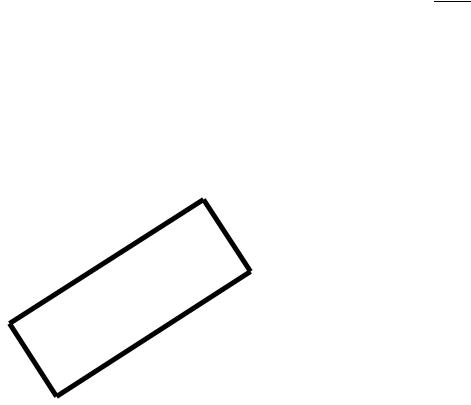
Highlights of the EOS C500/C500 PL
The Canon Digital Cinema Camera EOS C500/C500 PL has been designed with the discerning professional in mind. It is truly a cinematographer’s camera. The following are just some of the many features that will help turn your creative vision into reality.
5
Interchangeable lenses |
|
|
|
Enjoy the freedom of using interchangeable lenses |
3G-SDI and MON. terminals |
||
to achieve exactly the look you want. The EOS C500 |
The camera features dual 3G-SDI terminals (A43) |
||
features an EF lens mount allowing you to use over |
that can output 4K or 2K image data to an external |
||
|
COPY |
||
60 high-quality lenses from the Canon Cine Lens |
recorder. The dual MON. terminals (A43) are |
||
series and EF Lens series. The EOS C500 PL |
HD-SDI terminals that can output YCC 4:2:2 10-bit |
||
features a PL lens mount, allowing you to use a vast |
2K or full HD video, allowing external live monitoring |
||
array of cinematography lenses compatible with a |
during shoots using an external monitor with SDI |
||
Canon PL lens mount and other lenses commonly |
input. Of course, both sets of terminals also output |
||
used in motion picture production. |
|
audio, SMPTE time code (LTC) and user bit signals. |
|
4K, 2K and MXF modes |
|
Canon Log gamma for spectacular dynamic range |
|
In 4K and 2K modes, the camera outputs image |
The Canon Log gamma (A60) makes full use of |
||
data for recording with an external recorder. In 4K |
the sensor to give your recordings amazing dynamic |
||
mode, the camera outputs Canon RAW image data, |
|||
range. In 4K and 2K modes, the camera will always |
|||
which is free of compression noise. In 2K mode, the |
use Canon Log gamma. In MXF mode, you may |
||
camera outputs up to an RGB 4:4:4 12-bit signal. In |
want to use CINEMA preset (A60) to set the |
||
MXF mode, the camera records HD audio and video |
camera easily and quickly for shooting with Canon |
||
to CompactFlash (CF) cards. HD recordings are |
Log gamma. |
||
saved as Material eXchange Format (MXF) files and |
mode, you can select the system frequency, bit rate, |
||
4K Recording System with Cinema Quality |
|||
Advanced 4K-compatible Super 35mm CMOS |
resolution and frame rate of your recordings. These |
||
sensor |
|
options allow you to choose from a total of 27 |
|
The camera is equipped with a Super 35mm CMOS |
different combinations. |
||
sensor that captures video at an effective pixel count |
Recording media |
||
of 8.85 megapixels (4096x2160) and offers a center |
Because there are two CF card slots, when one CF |
||
resolution of 1,800 TV lines*. Furthermore, thanks to |
card slot becomes full, the recording will |
||
Canon’s high-sensitivity and low-noise technology, |
automatically continue on the other one without |
||
the camera can record at ISO levels up to 20,000 - a |
interruption when you use relay recording (A48). In |
||
level of sensitivity that must be seen to be believed! |
addition, using double slot recording (A48) lets |
||
* Varies depending on the lens used. |
|
you record the same clip simultaneously to both CF |
|
|
|
cards. |
|
are compatible with major non-linear editing (NLE) |
|
||
software. For example, you can use these MXF files |
Operability and Adaptability |
||
as proxy video for your NLE software. Furthermore, |
Freely customizable compact design |
||
even in 4K and 2K modes, the camera can record |
|||
The modular components, including the supplied |
|||
MXF files on a CF card. |
|
||
|
handle unit and monitor unit will let you expand and |
||
Multitude of recording options |
|
||
|
adapt the configuration to match your shooting |
||
The camera offers you numerous options when it |
conditions (A34). The articulated monitor unit can |
||
comes to the video configuration of your recordings. |
be rotated 270° for maximum convenience. The |
||
When recording in 4K or 2K mode, you can select |
10.1-cm (4-in.) LCD screen with 100% coverage |
||
the recording mode (RAW, HRAW, RGB 4:4:4 12- |
ensures that you can compose your shots with |
||
bit, RGB 4:4:4 10-bit or YCC 4:2:2 10-bit), system |
ease. |
||
frequency (59.94 Hz, 50.00 Hz, 24.00 Hz), resolution (various settings from 1920x1080 to 4096x2160) and frame rate (various settings from 23.98P up to 59.94P). This allows you to select a video configuration to suit your needs from a total of 44 different combinations. When recording in MXF
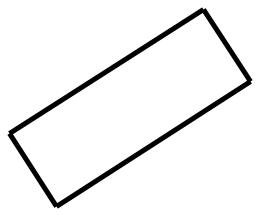
|
Pro-level connectivity |
|
Other Features |
|
|
In addition to the 3G-SDI terminals mentioned |
Special recording modes |
||
|
previously, the HD/SD SDI terminal can output YCC |
|||
|
The special recording modes (A105) give you more |
|||
|
4:2:2 10-bit (8-bit effective) HD/SD video as well as |
|||
|
creative control over your recordings. You can create |
|||
|
audio and time code signals. Genlock |
|
||
|
|
a slow motion or fast motion effect in your |
||
|
synchronization (A88), the TIME CODE terminal |
|||
|
recordings, record a certain number of frames at a |
|||
|
(A89, 91) and SYNC OUT terminal allow the |
|||
|
set interval (ideal for nature shots and other subjects |
|||
6 camera to be part of any multi-camera shooting |
||||
with little movement) or record a certain number of |
||||
|
setup. |
|
frames every time you press a button (ideal for stop |
|
|
|
|||
|
Customization |
|
||
|
|
motion animation). |
||
|
The camera features several customization options. |
Software for aiding the production workflow |
||
|
You can assign often-used functions to assignable |
|||
|
The Cinema RAW Development software, which |
|||
|
buttons (A111) so that you can call up those |
|||
|
can be downloaded from your local Canon Web site, |
|||
|
functions with the press of a single button. You can |
|||
|
can develop the 4K RAW data recorded with an |
|||
|
also register frequently-used menu settings in an |
|||
|
external recorder and export it as a standard file type |
|||
|
easy-to-access personal menu (My Menu, A32). |
|||
|
such as DPX. This helps make a smooth transition to |
|||
|
Custom functions (A123) and custom onscreen |
|||
|
the color grading process. |
|||
|
displays (A123) give you even more freedom to |
|||
|
Audio |
|||
|
control many aspects of the camera’s operation. |
|||
|
During MXF mode, with custom picture settings |
Sound is recorded as 2-channel linear PCM audio |
||
|
(A114), you can enjoy unparalleled image control |
(16-bit/48 kHz). You can use the MIC terminal for |
||
|
to deliver the “look” you want by adjusting |
microphones with a Ø 3.5 mm mini-stereo plug or the |
||
|
parameters, such as gamma and sharpness. The |
two XLR audio input terminals (with phantom power |
||
|
custom picture settings can be recorded onto an SD |
supply) when recording. |
||
|
card, which allows multiple C500 / C500 PL cameras |
Video scopes |
||
|
or C300 / C300 PL camcorders to use the same |
Check the brightness of the image using the |
||
|
settings, or embedded in the recording itself |
waveform monitor (A100), the color of the image |
||
|
(A116, 136, 164). |
|
using the vectorscope (A101), or the focus using |
|
|
Remote operation via Wi-Fi |
|
the edge monitor (A101). |
|
|
You can attach the optional WFT-E6 Wireless File |
|
||
|
|
COPY |
||
Transmitter to the camera and operate it remotely via Wi-Fi using the Wi-Fi Remote application (A51). The Wi-Fi Remote application lets you monitor the image through live view and remotely control the focus, shutter speed, ISO speed/gain and other settings.

7
1. Introduction 11 |
|
|
|
|
Preparing Recording Media 45 |
|
|
|
|||
About this Manual 11 |
|
|
|
|
Inserting a CF Card |
45 |
|
|
|
||
|
|
|
|
Checking the Status of the CF Card Slots |
45 |
||||||
Conventions Used in this Manual |
11 |
|
|||||||||
Supplied Accessories |
13 |
|
|
|
Removing a CF card |
46 |
|
|
|
||
|
|
|
Inserting and Removing an SD Card |
46 |
|
|
|||||
Names of Parts |
14 |
|
|
|
|
|
|
||||
Terminals 19 |
|
|
|
|
|
Initializing the Recording Media 47 |
|
|
|
||
Monitor Unit |
20 |
|
|
|
|
Switching Between the CF Card Slots |
48 |
|
|||
Handle Unit 22 |
|
|
|
|
Selecting the CF Card Recording Method |
48 |
|||||
4K Workflow Overview |
23 |
|
|
|
Checking the Available Recording Time for CF |
||||||
|
|
|
|
|
|
Cards 49 |
|
|
|
|
|
2. Preparations 25 |
|
|
|
|
Recovering Data on the CF Card 49 |
|
|
|
|||
Preparing the Power Supply |
25 |
|
|
Adjusting the Black Balance 50 |
|
|
|
||||
Using a Battery Pack |
25 |
|
|
|
Remote Operation Via the Wi-Fi Remote |
|
|
||||
Using a Household Power Outlet |
27 |
|
Application 51 |
|
|
|
|||||
|
Preparing the System for Wi-Fi Remote |
51 |
|||||||||
Turning the Camera On and Off |
28 |
|
|||||||||
|
|
|
|
|
|
||||||
Date, Time and Language Settings 29 |
|
3. Recording 53 |
|
|
|
|
|||||
Setting the Date and Time |
29 |
|
|
|
|
|
|
||||
|
|
Recording Video 53 |
|
|
|
|
|||||
Changing the Time Zone 29 |
|
|
|
|
|
|
|||||
|
|
reparing to Record |
53 |
|
|
|
|||||
Displaying the Date and Time while Recording |
30 |
|
|
|
|||||||
Recording 53 |
|
|
|
|
|||||||
Changing the Language 30 |
|
|
|
|
|
|
|||||
|
|
Remote Operation Using Wi-Fi Remote |
54 |
||||||||
Using the Menus 31 |
|
|
|
|
|||||||
|
|
|
|
Onscreen Displays |
57 |
|
|
|
|||
Selecting an Option from the Menu 31 |
|
|
|
|
|||||||
|
Rear Panel Displays |
59 |
|
|
|
||||||
Using the Customized Submenu (My Menu) 32 |
|
|
|
||||||||
Canon Log Gamma and CINEMA Preset |
|
60 |
|||||||||
Preparing the Camera |
34 |
|
|
|
|
||||||
|
COPY |
|
|
|
|
||||||
Preparing the Lens 34 |
|
|
|
Checking Clips Recorded with Canon Log Gamma |
|||||||
|
|
|
(View Assistance) 60 |
|
|
|
|||||
Attaching and Removing the Monitor Unit 37 |
|
|
|
|
|||||||
|
Using the Internal Cooling Fan 61 |
|
|
|
|||||||
Using the Viewfinder |
38 |
|
|
|
|
|
|
||||
|
|
|
Video Configuration: Type of Recording, |
|
|
||||||
Using the LCD Panel |
39 |
|
|
|
|
|
|||||
|
|
|
Resolution and Frame Rate 62 |
|
|
||||||
Adjusting the Viewfinder/LCD Screen 40 |
|
|
|
||||||||
|
Selecting the Video Configuration for 4K and 2K |
||||||||||
Using a Tripod 40 |
|
|
|
|
|||||||
|
|
|
|
Modes 62 |
|
|
|
|
|||
Attaching the Handle Unit |
41 |
|
|
|
|
|
|
||||
|
|
Selecting the Video Configuration for MXF |
|
||||||||
Attaching a Shoulder Strap |
41 |
|
|
|
|||||||
|
|
Mode 65 |
|
|
|
|
|||||
Removing and Attaching the Terminal Covers |
42 |
|
|
|
|
||||||
Changing Main Camera Functions with the FUNC. |
|||||||||||
Connecting to a 4Kor 2K-Compatible External |
|
||||||||||
|
Button 67 |
|
|
|
|
||||||
Recorder 43 |
|
|
|
|
Using the Direct Setting Mode 67 |
|
|
|
|||
|
|
|
|
|
|
Shutter Speed 68 |
|
|
|
|
|
|
|
|
|
|
|
Changing the Shutter Speed Mode and Value 69 |
|||||
|
|
|
|
|
|
Remote Operation Using Wi-Fi Remote |
69 |
||||
|
|
|
|
|
|
ISO Speed/Gain 71 |
|
|
|
|
|
|
|
|
|
|
|
Changing the ISO Speed or Gain Value |
71 |
||||
|
|
|
|
|
|
Using the Control Dial 72 |
|
|
|
||
|
|
|
|
|
|
Remote Operation Using Wi-Fi Remote |
72 |
||||
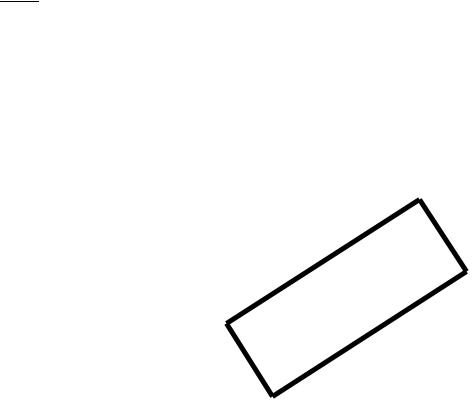
8
ND Filter 73 |
|
|
Color Bars/Audio Reference Signal |
99 |
|
|
Using the ND Filter 73 |
|
|
Recording Color Bars 99 |
|
|
|
Remote Operation Using Wi-Fi Remote |
73 |
Recording an Audio Reference Signal 99 |
||||
2Adjusting the Aperture |
74 |
|
Video Scopes 100 |
|
|
|
Using the Control Dial 74 |
|
|
Displaying a Video Scope 100 |
|
|
|
Remote Operation Using Wi-Fi Remote |
74 |
Configuring the Waveform Monitor |
100 |
|
||
White Balance 76 |
|
|
Configuring the Vectorscope |
101 |
|
|
Setting the White Balance |
76 |
|
Configuring the Edge Monitor |
101 |
|
|
Remote Operation Using Wi-Fi Remote |
77 |
Adding Marks while Recording MXF Clips |
102 |
|||
Adjusting the Focus 79 |
|
|
Adding Shot Marks while Recording |
102 |
||
Adjusting the Focus Manually 79 |
|
Remote Operation Using Wi-Fi Remote |
102 |
|||
2Remote Operation Using Wi-Fi Remote 79 |
Adding an $Mark or %Mark to the Last Clip |
|||||||
Using the Focus Assistance Functions |
80 |
Recorded 103 |
|
|
|
|||
Onscreen Markers and Zebra Patterns |
82 |
Remote Operation Using Wi-Fi Remote |
103 |
|||||
Displaying Onscreen Markers |
82 |
|
|
Reviewing an MXF Clip 104 |
|
|
||
Displaying Zebra Patterns 83 |
|
COPY |
105 |
|
|
|||
|
|
|
Special Recording Modes |
|
|
|||
Setting the Time Code 84 |
|
|
|
Interval Recording Mode |
105 |
|
|
|
Selecting the Running Mode 84 |
|
|
Frame Recording Mode |
106 |
|
|
||
Selecting Drop or Non-Drop Frame 85 |
Slow & Fast Motion Mode 108 |
|
|
|||||
Putting the Time Code Display on Hold |
85 |
Pre-recording Mode 110 |
|
|
||||
Setting the User Bit 87 |
|
|
|
|
4. Customization 111 |
|
|
|
Synchronizing with an External Device |
88 |
|
|
|
||||
Connecting an External Device |
88 |
|
Assignable Buttons 111 |
|
|
|
||
Reference Video Signal Input (Genlock |
|
Changing the Assigned Function |
111 |
|
||||
Synchronization) |
88 |
|
|
|
Using an Assignable Button 112 |
|
||
Time Code Signal Input |
89 |
|
|
|
Custom Picture Settings |
114 |
|
|
Reference Video Signal Output |
90 |
|
Selecting Custom Picture Files 114 |
|
||||
Time Code Signal Output 91 |
|
|
|
Editing a Custom Picture File’s Settings |
114 |
|||
Recording Audio 92 |
|
|
|
|
Renaming Custom Picture Files |
115 |
|
|
Connecting an External Microphone or External |
Protecting Custom Picture Files |
115 |
|
|||||
Audio Input Source to the Camera 92 |
Transferring Custom Picture Files |
115 |
|
|||||
Selecting the Audio Input from the XLR |
|
Embedding Custom Picture Settings in a |
|
|||||
Terminals 93 |
|
|
|
|
Recording 117 |
|
|
|
Adjusting the Audio Level from the XLR |
|
Available Custom Picture Settings 117 |
|
|||||
Terminals 94 |
|
|
|
|
Customizing Functions and Onscreen |
|
||
Adjusting the Audio Level from the MIC |
|
|
||||||
|
Displays 123 |
|
|
|
||||
Terminal 95 |
|
|
|
|
Customizing Functions |
123 |
|
|
Monitoring the Audio with Headphones |
96 |
Customizing Onscreen Displays |
123 |
|
||||
Using Metadata 97 |
|
|
|
|
Saving and Loading Camera Settings 125 |
|||
Setting a User Memo Created with Canon XF |
Saving Camera Settings to an SD Card |
125 |
||||||
Utility 97 |
|
|
|
|
Loading Camera Settings from an SD Card 125 |
|||
Setting a User Memo Using Wi-Fi Remote 98 |
|
|
|
|
||||
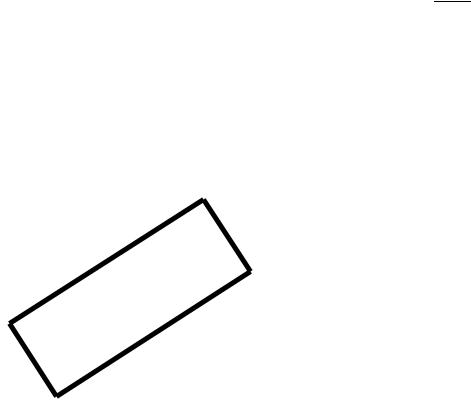
9
5. Playback 127 |
|
|
|
|
Developing RAW Clips |
150 |
|
|
|
|||||
Playing Back MXF Clips 127 |
|
|
System Requirements |
150 |
|
|
|
|||||||
|
|
Installing and Uninstalling Cinema RAW |
|
|||||||||||
Clip Index Screen |
127 |
|
|
|
||||||||||
Playing Back Clips |
|
128 |
|
|
|
Development (Windows) |
150 |
|
||||||
|
|
|
Installing and Uninstalling Cinema RAW |
|
||||||||||
Onscreen Displays |
|
129 |
|
|
|
|||||||||
|
|
|
|
Development (Mac OS) |
151 |
|
|
|||||||
Playback Controls |
130 |
|
|
|
|
|
||||||||
|
|
Viewing the Software Instruction Manual |
151 |
|||||||||||
Audio Output |
131 |
|
|
|
|
|||||||||
|
|
|
|
Saving MXF Clips to a Computer 152 |
|
|||||||||
MXF Clip Operations |
|
132 |
|
|
|
|||||||||
|
|
|
System Requirements |
152 |
|
|
|
|||||||
Using the Clip Menu |
132 |
|
|
|
|
|
||||||||
|
|
Installing and Uninstalling Canon XF Utility |
|
|||||||||||
Displaying Clip Information 133 |
|
|
||||||||||||
|
|
(Windows) |
153 |
|
|
|
|
|||||||
Adding $ Marks or %Marks |
134 |
|
|
|
|
|
|
|||||||
|
Installing and Uninstalling Canon XF Utility |
|
||||||||||||
Deleting $ Marks or % Marks |
134 |
|
|
|||||||||||
|
|
(Mac OS) |
155 |
|
|
|
|
|
||||||
Copying Clips |
135 |
|
|
|
|
|
|
|
|
|
||||
|
|
|
Viewing the Software Instruction Manuals |
158 |
||||||||||
Deleting Clips |
136 |
|
|
|
|
|||||||||
|
|
|
|
|
|
|
|
|
|
|
|
|||
Deleting the User Memo and GPS |
|
7. Photos 159 |
|
|
|
|
|
|
||||||
Information 136 |
|
|
|
|
|
|
|
|
||||||
|
|
Taking |
hotos 159 |
|
|
|
|
|
||||||
Copying a Custom Picture File Embedded in a |
|
|
|
|
|
|||||||||
Taking Photos in CAMERA Mode |
159 |
|
||||||||||||
Clip 136 |
|
|
|
|
|
|
||||||||
|
|
|
|
|
Capturing Photos in MEDIA Mode |
159 |
|
|||||||
Displaying an Index Screen of Shot Marks |
137 |
|
||||||||||||
Photo Playback |
161 |
|
|
|
|
|
||||||||
Displaying a Frame Index Screen of a Single |
|
|
|
|
|
|||||||||
Displaying the [Photos] Index Screen 161 |
||||||||||||||
Clip 138 |
|
|
|
|
|
|||||||||
|
|
|
|
|
Viewing Photos |
161 |
|
|
|
|
||||
Adding Shot Marks |
|
138 |
|
|
|
|
|
|
||||||
|
|
|
Photo Operations |
162 |
|
|
|
|
||||||
Deleting Shot Marks |
139 |
|
|
|
|
|
|
|||||||
|
|
Using the Photo Menu |
162 |
|
|
|
||||||||
|
|
|
|
|
|
|
|
|
||||||
Changing a Clip’s Thumbnail 139COPY |
162 |
|
|
|
|
|||||||||
|
|
|
|
|
|
Deleting Photos |
|
|
|
|
||||
6. External Connections 141 |
|
|
Protecting Photos 163 |
|
|
|
||||||||
|
|
Copying Custom Picture Files |
164 |
|
||||||||||
Video Output Configuration 141 |
|
|
|
|||||||||||
|
|
Photo Numbering 165 |
|
|
|
|||||||||
Video Configuration and Video Output |
|
|
|
|
||||||||||
|
|
|
|
|
|
|
|
|
||||||
Configuration for 4K and 2K Modes |
141 |
8. Additional Information 167 |
|
|
||||||||||
Video Output Configuration for MXF Mode |
143 |
|
|
|||||||||||
Menu Options 167 |
|
|
|
|
|
|||||||||
Connecting to an External Monitor 144 |
|
|
|
|
|
|
||||||||
|
Displaying the Status Screens |
178 |
|
|
||||||||||
Connection Diagram 144 |
|
|
|
|
||||||||||
|
|
Troubleshooting |
184 |
|
|
|
|
|
||||||
Using the MON. 1 and MON. 2 Terminals |
145 |
|
|
|
|
|
||||||||
List of Messages 187 |
|
|
|
|
||||||||||
Using the HD/SD SDI Terminal |
147 |
|
|
|
|
|
||||||||
|
Handling Precautions |
191 |
|
|
|
|||||||||
Using the HDMI OUT Terminal |
147 |
|
|
|
|
|||||||||
|
Maintenance/Others |
194 |
|
|
|
|||||||||
Using the SYNC OUT Terminal |
147 |
|
|
|
|
|||||||||
|
Optional Accessories |
197 |
|
|
|
|||||||||
Selecting the Resizing Method for SD Video 148 |
|
|
|
|||||||||||
Specifications 200 |
|
|
|
|
|
|||||||||
Superimposing Onscreen Displays to Appear on |
|
|
|
|
|
|||||||||
Index |
205 |
|
|
|
|
|
|
|||||||
an External Monitor 149 |
|
|
|
|
|
|
|
|
||||||
|
|
|
|
|
|
|
|
|
|
|||||

10
COPY
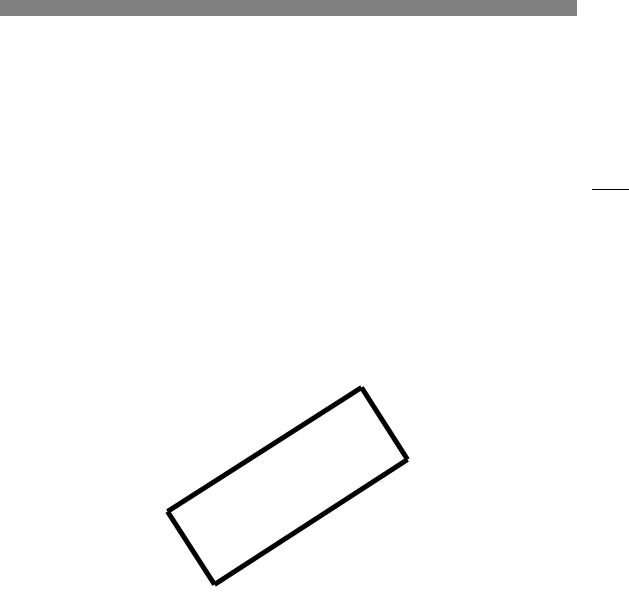
1 |
Introduction |
|
11
About this Manual
Thank you for purchasing the Canon EOS C500/C500 PL. Please read this manual carefully before you use the camera and retain it for future reference. Should the camera fail to operate correctly, refer to Troubleshooting (A184).
Conventions Used in this Manual
• IMPORTANT: Precautions related to the camera’s operation.
IMPORTANT: Precautions related to the camera’s operation.
• NOTES: Additional topics that complement the basic operating procedures.
NOTES: Additional topics that complement the basic operating procedures.
•A: Reference page number.
•2: Text that applies only to the model shown in the icon.
•The following terms are used in this manual.
“Screen” refers to the LCD screen and the viewfinder screen.
“CF card” refers to a CompactFlash (CF) card. “SD card” refers to an SD or SDHCCOPYmemory card.
“Recording media” refers to CF cards and SD cards.
•Photographs in the manual are simulated pictures taken with a still camera. Some screenshots have been altered to make them easier to read.
•Illustrations in the manual show the anon E S 500 camera with a Canon EF 50mm f/1.4 USM lens attached.
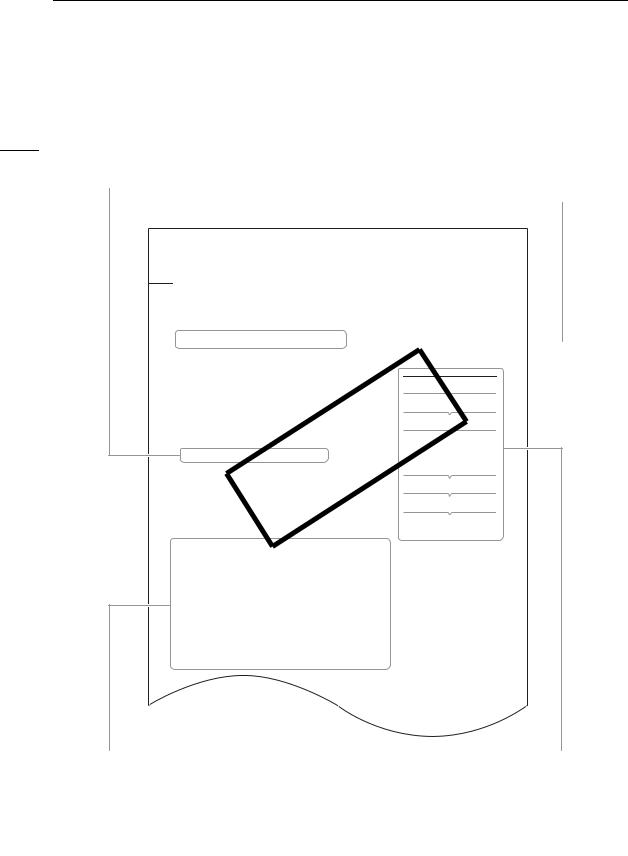
About this Manual
The arrow is used to abbreviate menu selections. For a detailed explanation on how to use the menus, refer to Using the
12Menus (A31). For a concise summary of all available menu options and settings, refer to the appendix Menu Options (A167).
Setting the Time Code
Operating modes
 indicates that a function is available in the operating mode (the two icons left of the dividing bar) and system priority (the three icons to the right of the dividing bar) indicated and
indicates that a function is available in the operating mode (the two icons left of the dividing bar) and system priority (the three icons to the right of the dividing bar) indicated and  indicates that the
indicates that the
function is not available. For a detailed explanation, refer to Turning the Camera On and Off (A28) and Selecting the System Priority (A62, 65).
While recording, the camera can generate a time code signal and embed it in your recordings. You can have the camera output the time code signal from the 3G-SDI terminals, MON. terminals, HD/SD SDI terminal or TIME
84CODE terminal (A91). In addition, you can superimpose the time code on video output from the HDMI OUT terminal or SYNC OUT terminal. While playing back video recorded on a CF card, you can output the time code on the CF card from the HD/SD SDI terminal or TIME CODE terminal. Additionally, you can superimpose the time code on the picture from the HDMI OUT terminal or SYNC OUT terminal. For recordings with a frame rate of 29.97P, 59.94i or 59.94P, you can also select between a drop frame and non-drop frame time code.
To synchronize the camera s time code to an external time code generator, refer to Synchronizing with an External Device (A88).
Operating modes: 







Selecting the Running Mode
[¤TC/UB Setup]
4 Select the desired option and then press SET.
During MXF mode, you can select the running mode of the camera s time |
|
||
code. During 4K and 2K modes, the running mode will be set to [Free |
[Time Code] |
||
Run] during normal shooting and slow & fast recording mode; it will be set |
|||
|
|||
to [Rec Run] during interval recording and frame recording modes. ou |
[Mode] |
||
can set the time code s initial value, however, by performing the procedure |
|||
in the following section Setting the Time Code s Initial Value. |
|
||
1 Open the time code [Mode] submenu. |
[Preset] |
||
|
|||
[¤TC/UB Setup] >[Time Code] >[Mode] |
|
||
2 Select the desired option and then press SET. |
[¤TC/UB Setup] |
||
€ If you selected [Regen.], you do not need to perform the rest of this |
|
||
procedure. If you selected [Preset] and would like to set the time |
[Time Code] |
||
code s initial value, see the following section Setting the Time Code s |
|
||
Initial Value. |
|
[Run] |
|
|
|
||
3 After you select [Preset], open the time code [Run] submenu. |
|
||
[¤TC/UB Setup] >[Time ode] >[Run] |
[Free Run] |
||
|
COPY |
|
|
|
|
||
Options
[Preset]: The time code starts from an initial value you can select in advance. The default initial time code is 00:00:00.00. The time code s running mode depends on the [Run] setting.
[Rec Run]: The time code runs only while recording so clips recorded consecutively on the same CF card will have continuous time codes.
[Free Run]:The time code starts running the moment you press SET to select this option and keeps running regardless of the camera s operation.
[Regen.]: The camera will read the selected CF card and the time code will continue from the last recorded time code on the CF card. The time code runs only while recording so clips recorded consecutively on the same CF card will have continuous time codes.
When a procedure requires selecting an option, the available options are listed within or after the procedure. Brackets [ ] are used to refer to menu options as they are displayed on screen.
When a function requires the use of the menu, the quick reference shows the submenus and, when applicable, the default setting for the menu item. The example illustration indicates that you can find the function by selecting the [¤TC/ UB Setup] menu and then the [Time Code] menu item.
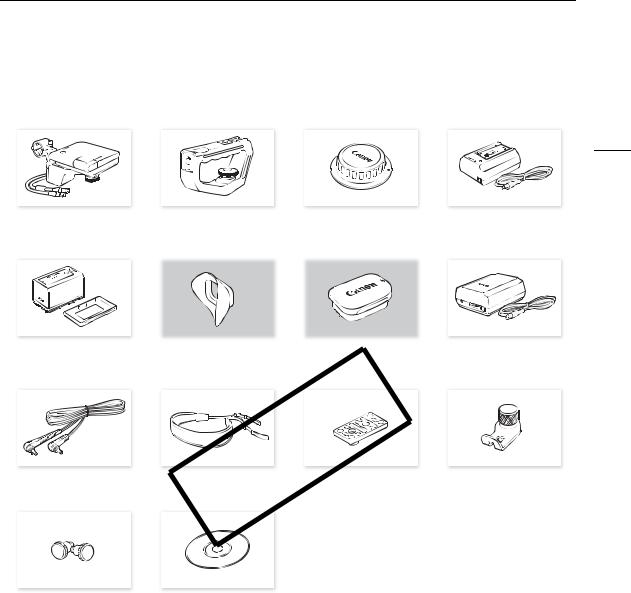
Supplied Accessories
Supplied Accessories
The following accessories are supplied with the camera.
13
Monitor Unit
BP-955 Battery Pack
(incl. terminal cover)
DC-940 DC Cable
(incl. cable tie)
Tape Measure Hooks1 (x 2)
Handle Unit |
|
Body Cap1 |
|
|
|
|
|
|
Eye Cup Viewfinder Cap
COPY |
|
SS-1200 Shoulder Strap |
Adapter Base for 0.64 cm (1/4 in.) |
Tripods
Canon XF Utilities Disc3
Battery Charger CG-940
(incl. power cord)
CA-940 Compact Power Adapter
(incl. power cord)
WFT Attachment Bracket2
1 Comes pre-attached to the camera.
2 Used to secure the optional WFT-E6 Wireless File Transmitter, when it is attached to the camera.
3 The Canon XF Utilities Disc includes software for saving and managing MXF clips on a computer. For details on installing the software, refer to Saving MXF Clips to a Computer (A152). For more information on the functions, refer to the ‘Canon XF Utility Instruction Manual’ (PDF file) after you install the software.
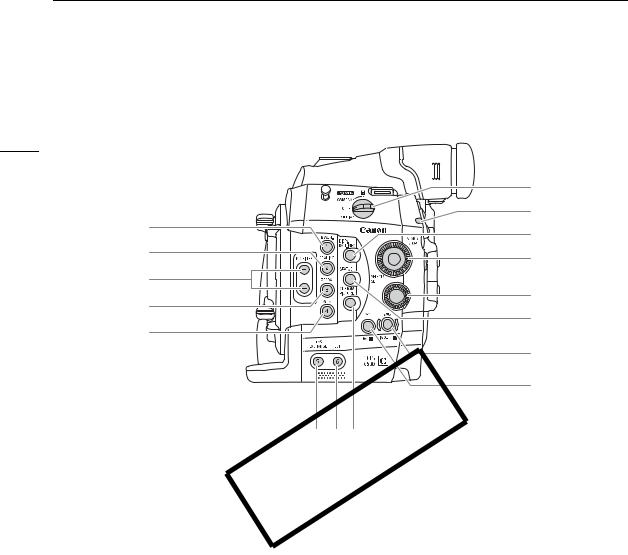
Names of Parts
Names of Parts
14
|
6 |
|
1 |
7 |
|
8 |
||
2 |
||
9 |
||
|
||
3 |
10 |
|
4 |
||
11 |
||
5 |
||
|
||
|
12 |
|
|
13 |
|
|
COPY |
||
|
|
|
14 15 16 |
|
1 |
MAGN. (magnification) button (A80)/ |
10 |
Control dial (A72, 74) |
|
|
Assignable button 1 (A111) |
|
11 |
STATUS button (A178) |
2 |
PEAKING button (A80) / |
|
12 |
Å(white balance adjustment) button (A76)/ |
|
Assignable button 2 (A111) |
|
|
INDEX button (A128)/Ñ(stop) button (A128) |
3 |
ND FILTER +/- buttons (A73) |
|
13 |
u(review recording) button (A104)/Ò |
4 |
ZEBRA button (A83)/ |
|
|
(play/pause) button (A128) |
|
Assignable button 3 (A111) |
|
14 |
LENS EXCHANGE button (A36)/Assignable |
5 |
WFM (waveform monitor) button (A100)/ |
|
button 5 (A111) |
|
|
Assignable button 4 (A111) |
|
15 |
LUT (lookup table) button (A146)/Assignable |
6 |
Qswitch (A28) |
|
|
button 6 (A111) |
7 |
Tally lamp (A53) |
|
16 |
CUSTOM PICTURE button (A114) |
8DISP. (display) button (A57,129)/BATT. INFO (battery information) button (A26)
9SELECT dial/SET button (A31)
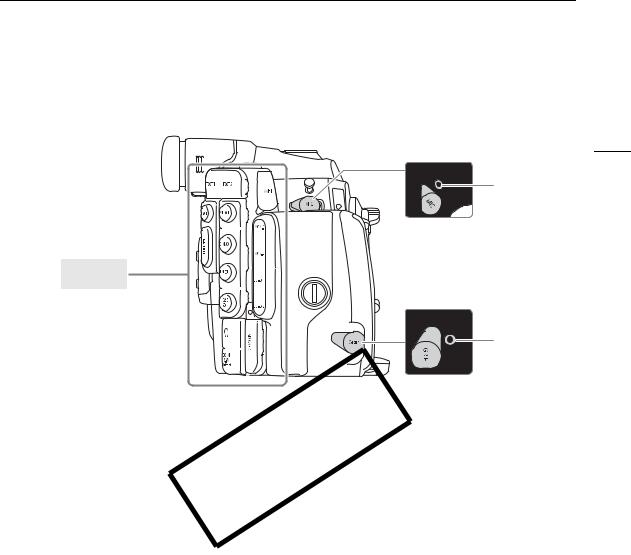
Names of Parts
15
17
Terminals
(A19)
18
COPY |
|
17 MIC (microphone) terminal (A92) |
18 GRIP terminal |
This terminal is the same as the grip unit connection terminal on the C300 / C300 PL camcorder.
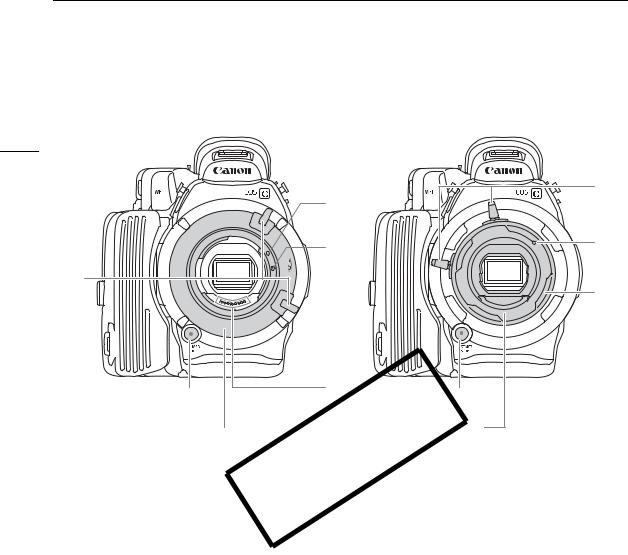
Names of Parts
2 3
16
19
23
2EF Lens mount 
19Mount handle (A35)
20EF Lens mount index (A34)
21EF-S Lens mount index (A34)
22EF Lens contacts (A34)
23START/STOP button (A53)
20
21
22 |
|
23 |
|
COPY |
|||
|
|||
3 L Lens mount |
|||
24 |
Bayonet ring handles (A37) |
||
25 |
L Lens index pin (A37) |
||
26 |
Bayonet ring (A37) |
||
24
25
26
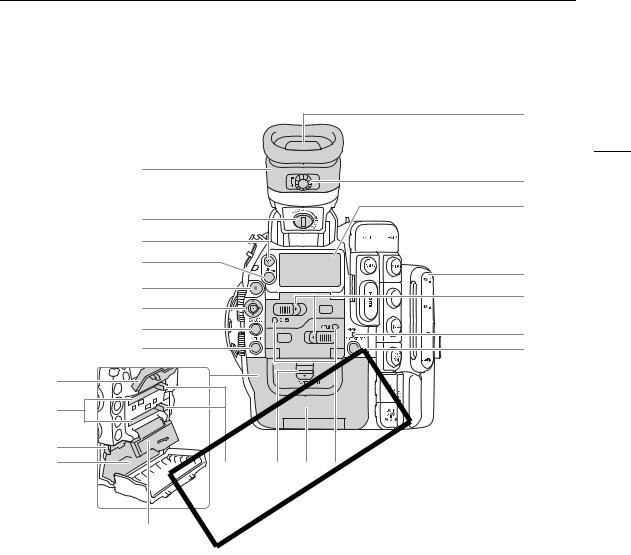
Names of Parts
|
39 |
|
17 |
27 |
40 |
|
|
28 |
41 |
|
|
29 |
|
30 |
42 |
|
|
31 |
|
|
|
43 |
|
32 |
|
|
|
|
|
|
|
|
|
|
|
33 |
|
|
|
44 |
|
34 |
|
|
|
|
|
|
|
|
45 |
|
35 |
|
COPY |
|||
36 |
|
||||
|
|
|
|
|
|
37 |
|
|
|
|
|
38 |
|
46 |
47 |
48 |
49 |
|
|
||||
|
35 |
|
|
|
|
27 |
Viewfinder unit |
41 |
Rear panel (A59) |
||
28 |
Viewfinder unit LOCK/RELEASE screw (A194) |
42 |
MON./3G-SDI terminal cover (A43) |
||
29 |
|
|
(rear panel’s backlight) button (A59) |
43 |
CF card slot cover switches for CF card slots |
|
|
||||
30 |
FUNC. (main functions) button (A67) |
|
A (top) and B (bottom) (A45) |
||
31 |
START/STOP button (A53) |
44 |
RESET button (A186) |
||
32 |
Joystick (A31)/SET button (A31) |
45 |
SLOT SELECT (CF card slot selection) button |
||
33 |
CANCEL button (A31) |
|
(A48, 128) |
||
34 |
MENU button (A31) |
46 |
CF card release buttons for CF card slots A (top) |
||
35 |
CF card slot covers for CF card slots A (top) and |
|
and B (bottom) (A46) |
||
|
B (bottom) |
47 |
BATT. OPEN (open battery compartment) switch |
||
36 |
CF card slots A (top) and B (bottom) (A45) |
|
(A26) |
||
37 |
RELEASE (battery release) latch (A26) |
48 |
Battery compartment cover (A26) |
||
38 |
Battery compartment |
49 |
CF2(CF card slot A) and CF3(CF card slot B) |
||
39 |
Viewfinder (A38, 40) |
|
access indicators (A45) |
||
40 |
Dioptric adjustment dial (A38) |
|
|
||

Names of Parts
18
|
51 |
|
52 |
|
53 |
50 |
54 |
|
|
|
53 |
50 |
Tape measure hooks |
|
53 |
Strap mounts (A41) |
|
|
Use the hooks to accurately measure the distance |
54 |
Accessory shoe with mounting hole for |
||
|
from the focal plane. |
|
|
0.64 cm (1/4 in.) screws |
|
51 |
Focal plane marks |
COPY |
|
||
|
|
For attaching accessories such as the optional |
|||
52 |
Socket for the WFT Attachment Bracket (A51) |
|
VL-10Li II Battery Video Light. |
|
|
|
|
|
|
|
57 |
58
55
56
55 |
TB-1 Tripod Base for tripods with 0.95 cm (3/8 in.) |
57 |
Attachment sockets for the optional TA-100 Tripod |
|
screws (A40) |
|
Adapter (A40) |
56 |
Tripod socket (A40) |
58 |
Tripod base screws (A40) |
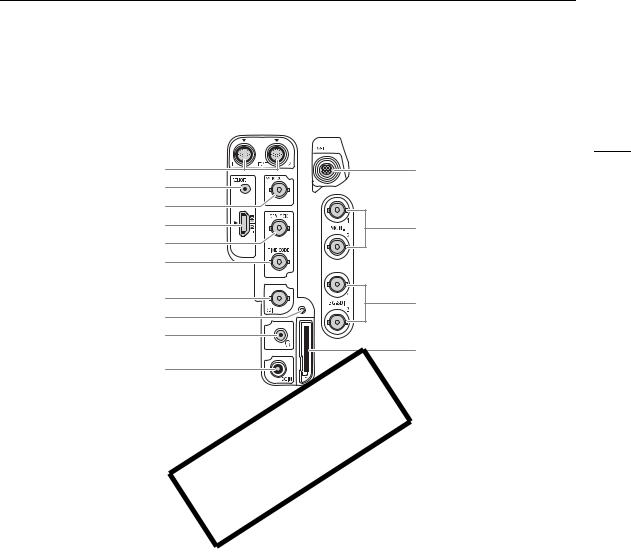
Names of Parts
Terminals
19
|
59 |
|
|
69 |
|
60 |
|
|
|
|
61 |
|
|
|
|
62 |
|
|
70 |
|
63 |
|
|
|
|
64 |
|
|
|
|
65 |
|
|
71 |
|
66 |
|
|
|
|
|
|
|
|
|
67 |
|
|
72 |
|
|
|
|
|
|
68 |
COPY72 SD card slot (A46) |
||
63 |
GENLOCK terminal (A88) |
|||
59 |
EXT (modular unit) terminals 1 and 2 (A37) |
65 |
HD/SD SDI terminal (A147) |
|
60 |
REMOTE terminal |
|
66 |
SD card access indicator (A46) |
|
For connecting commercially available remote |
67 |
×(headphone) terminal (A96) |
|
|
controllers. |
|
68 |
DC IN terminal (A27) |
61 |
SYNC OUT (synchronizing signal output) terminal |
69 |
WFT terminal (A51) |
|
|
(A90,147) |
|
70 |
MON. (external monitor) terminals 1 and 2 (A43) |
62 |
HDMI OUT terminal (A147) |
|
71 |
3G-SDI terminals 1 and 2 (A43) |
64 |
TIME CODE terminal (A89, 91) |
|
|
|
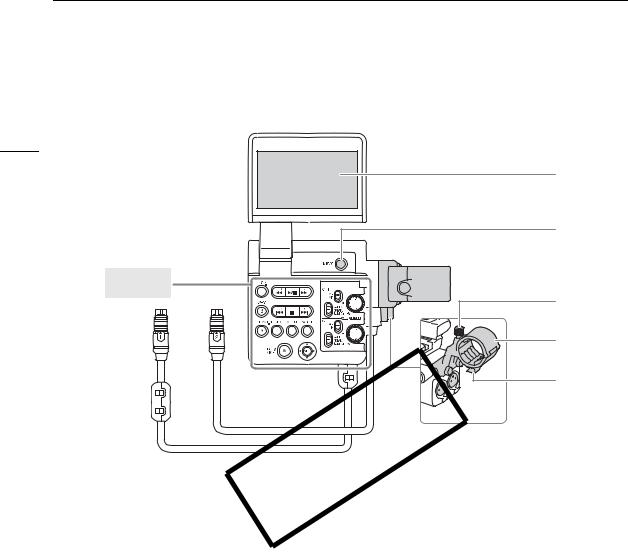
Names of Parts
Monitor Unit
20
Operation panel
(A21)
COPY
1LCD panel
2MIRROR button (A39)
3 Microphone lock screw (A92)
4Microphone holder (A92)
5 Microphone cable clamp (A92)
6XLR terminals CH1 (right) and CH2 (left) (A92)
1
2
3
4
5
6

Names of Parts
Operation panel
21
13 14 15 16 17 |
18 |
7 |
19 |
|
8 |
||
|
||
9 |
|
|
10 |
|
|
11 |
20 |
|
12 |
||
|
|
|
COPY |
||||
|
|
21 |
22 |
23 |
24 |
|
7 |
DISP. (display) button (A57, 129) |
|
|
16 |
Ù(skip forward) button (A130)/ |
|
8 |
Ñ(stop) button (A128)/ |
|
|
|
|
Assignable button 15 (A111) |
|
Assignable button 14 (A111) |
|
|
|
17 |
XLR terminal switches for CH1 (top) and CH2 |
9 |
WFM (waveform monitor) button (A100)/ |
|
|
(bottom) (A93) |
||
|
Assignable button 8 (A111) |
|
|
|
18 |
Protective cover for XLR audio controls (A94) |
10 |
Ú(skip backward) button (A130)/ |
|
|
19 |
ãswitches for CH1 (top) and CH2 |
|
|
Assignable button 13 (A111) |
|
|
|
|
(bottom) (A94) |
11 |
EDGE MON. (edge monitor) button (A100)/ |
|
20 |
ãdials for CH1 (top) and CH2 (bottom) |
||
|
Assignable button 9 (A111) |
|
|
|
|
(A94) |
12 |
INDEX button (A128) |
|
|
|
21 |
START/STOP button (A53) |
13 |
Ø(fast reverse playback) button (A130)/ |
|
22 |
MENU button (A31) |
||
|
Assignable button 10 (A111) |
|
|
|
23 |
Joystick (A31)/SET button (A31) |
14 |
Ò(play/pause) button (A128)/ |
|
|
24 |
CANCEL button (A31) |
|
|
Assignable button 11 (A111) |
|
|
|
|
|
15×(fast playback) button (A130)/ Assignable button 12 (A111)
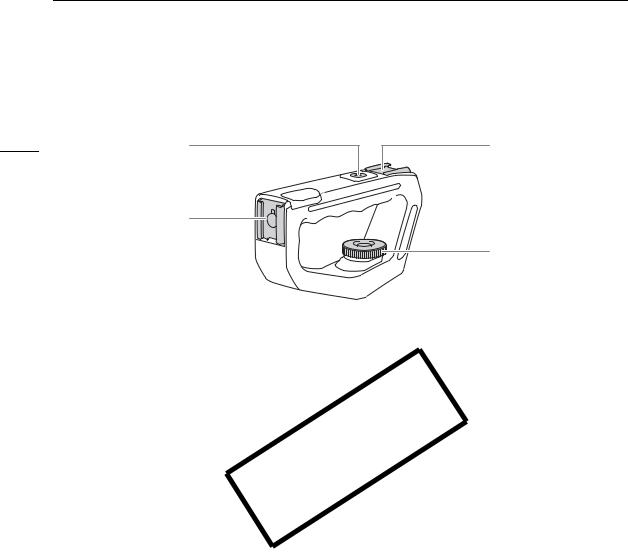
Names of Parts
Handle Unit
22 |
1 |
3 |
|
2
4
1 Mounting hole for 0.64 cm (1/4 in.) screws
2Front accessory shoe
3 Top accessory shoe
4Lock screw (A41)
COPY
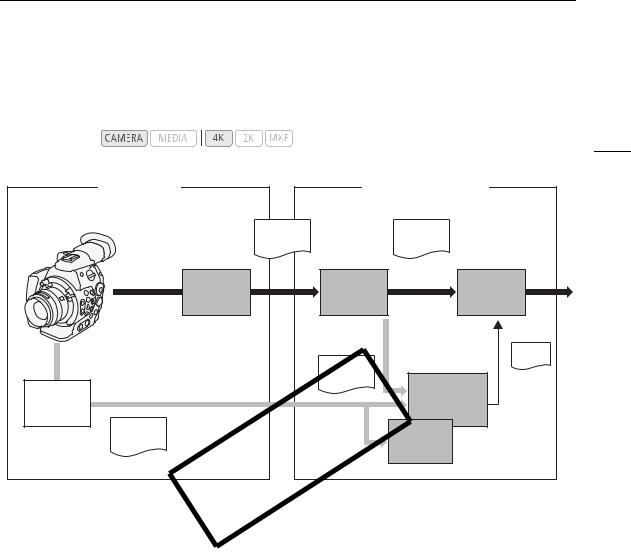
4K Workflow Overview
4K Workflow Overview
The following illustrates the typical 4K workflow for this camera.
Operating modes: |
|
|
|
23 |
Recording |
|
Post-production |
|
|
|
|
RAW data |
Full-quality |
|
|
data |
|
||
|
|
|
|
|
3G-SDI |
|
|
|
|
|
|
|
|
|
connection |
External 4K |
Cinema |
Color |
|
|
RAW |
|
||
|
recorder |
grading |
|
|
|
Development |
|
||
|
|
|
|
|
|
RAW recording |
|
|
|
|
|
|
|
EDL |
|
|
Proxy data |
|
|
|
|
|
||
Shoot in 4K mode (A62) andCOPYrecord 4K RAW data using an external recorder connected to the camera’s 3G-SDI terminals (A43).
Insert a CF card into the camera to record an MXF clip simultaneously with the 4K RAW data (A64).
Develop the RAW data using the Cinema RAW Development software (A150) to generate fullquality data.
•You can also generate proxy data with the software.
Transfer the MXF file or proxy data generated by the software to your NLE system and edit offline (A152).
Perform color grading based on the full-quality data and the edit decision list (EDL) created fromNLE
offline editing.
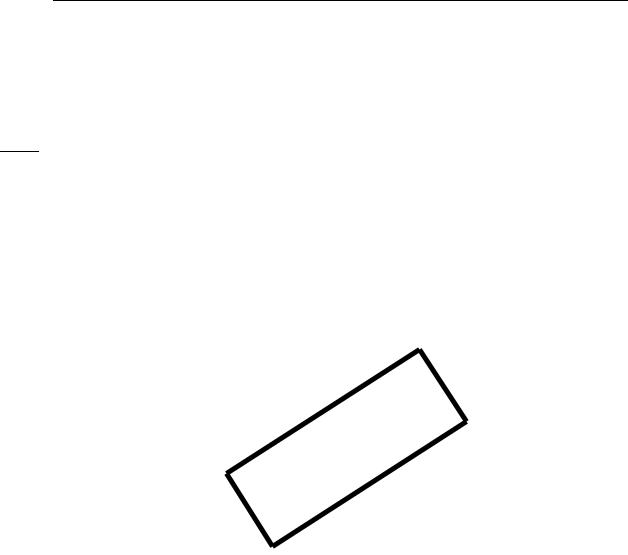
4K Workflow Overview
24
COPY
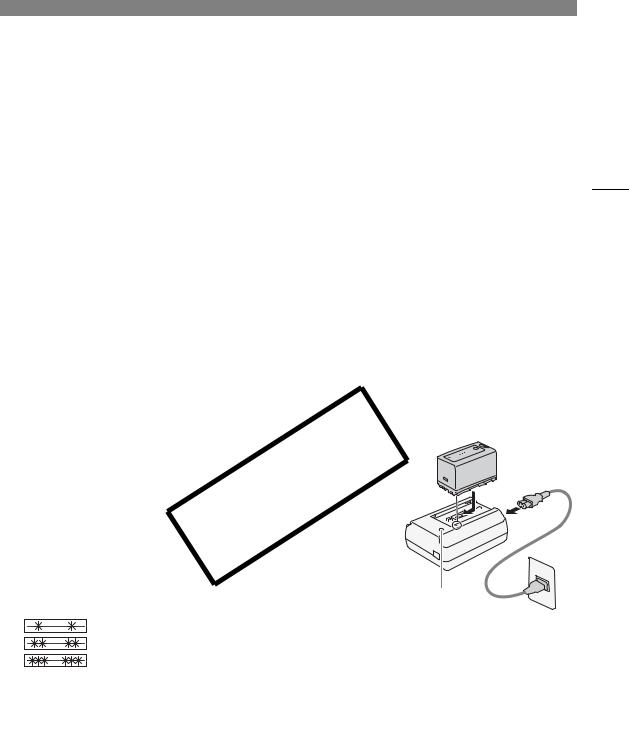
2 |
Preparations |
|
25
Preparing the Power Supply
You can power the camera using a battery pack or directly using the compact power adapter. If you connect the compact power adapter to the camera while a battery pack is attached, the camera will draw power from the power outlet.
Charge battery packs before use. For approximate charging times and recording/playback times with a fully charged battery pack, refer to Charging Times (A198) and Recording and Playback Times (A198).
Using a Battery Pack
You can power the camera using the supplied BP-955 or an optional BP-950G, BP-970G or BP-975 Battery Pack*. The BP-955 and BP-975 are compatible with Intelligent System, meaning that you can check the remaining battery time.
*The optional BP-970G / BP-975 Battery Pack was not originally designed for use with this camera. Because of its size, you will not be able to close the battery compartment cover when using one (A192).
3Attach the battery pack to the batteryCOPYcharger.
•Press lightly and slide the battery pack in the direction of the arrow until it clicks.
•The CHARGE indicator starts flashing and also indicates the battery pack’s
approximate charge. The indicator will stay on when charging has completed. CHARGE indicator
0-34%: Flashes once per second
35-69%: Flashes twice per second
70-99%: Flashes 3 times per second
4 When charging has completed, remove the battery pack from the battery charger.
5 Unplug the power cord from the power outlet and disconnect it from the battery charger.
 IMPORTANT
IMPORTANT
• Do not connect to the battery charger any product that is not expressly recommended for use with this camera.
 NOTES
NOTES
•We recommend charging the battery pack in temperatures between 10 ºC and 30 ºC (50 ºF and 86 ºF). Outside the temperature range of 0 ºC to 40 ºC (32 ºF to 104 ºF), charging will not start.
•If there is a malfunction with the battery charger or battery pack, the CHARGE indicator will go out and charging will stop.
•For handling precautions regarding the battery pack, refer to Battery Pack (A191).
•Charged battery packs continue to discharge naturally. Therefore, charge them on the day of use, or the day before, to ensure a full charge.
•We recommend that you prepare battery packs to last 2 to 3 times longer than you think you might need.

Preparing the Power Supply
Attaching the Battery Pack
1 |
Set the Qswitch to OFF. |
|
2 |
Slide the BATT. OPEN switch in the direction of the arrow and open |
|
26 |
|
the battery compartment cover. |
|
|
|
3 |
Insert the battery pack all the way into the compartment as shown |
|
|
|
in the illustration and press it gently toward the left until it clicks. |
4 |
Close the battery compartment cover. |
|
Removing the Battery Pack |
|
|
1 |
Set the Qswitch to OFF. |
|
2 |
Slide the BATT. OPEN switch in the direction of the arrow and open |
|
|
the battery compartment cover. |
COPY |
|
|
|
3 |
Holding down the RELEASE latch, slide the battery pack toward the |
|
|
right and then pull it out. |
|
4 |
Close the battery compartment cover. |
|
Checking the Remaining Battery Charge
When the camera is turned on, you can check the remaining battery
charge by looking at any recording/playback screen or the [Battery/Hour Meter] status screen (A182). When the camera is turned off, use one of the following methods to check the approximate remaining battery charge.
For batteries compatible with Intelligent System, press the CHECK button. An indicator will light for approximately 3 seconds and show the approximate remaining battery charge.
0-25%
CHECK button
26-50%
51-75%
76-100%
Battery charge indicator
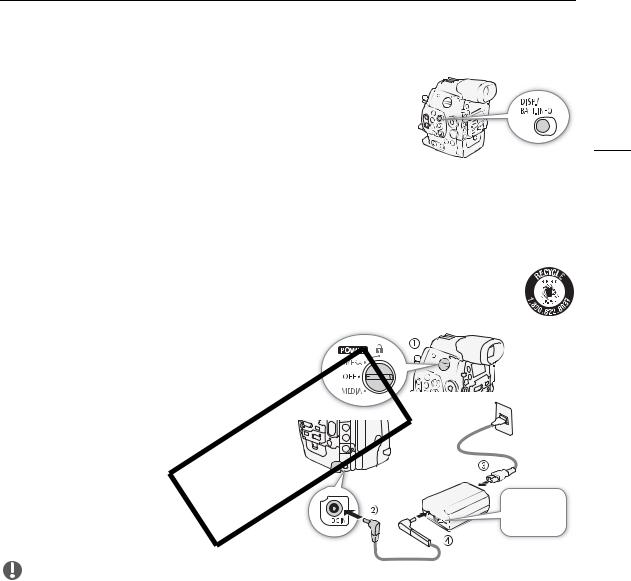
Press the BATT. INFO button to display the remaining battery level indicator (displays for 5 seconds). Depending on the battery life, the battery information may not be displayed.
 NOTES
NOTES
Preparing the Power Supply
27
•The first time you use a battery pack, fully charge it and then use the
camera until the battery pack is completely exhausted. Doing so will ensure that the remaining recording time will be displayed accurately.
•Repeatedly charging and discharging the battery pack will eventually shorten its battery life. You can check the battery life on the [Battery/Hour Meter] status screen (A182) or the battery information screen (press the BATT. INFO button while the camera is turned off). Fully charging the battery pack and then discharging it will give you a more accurate reading.
• USA and Canada only: The Lithium ion/polymer battery that powers the product is recyclable. Please call 1-800-8-BATTERY for information on how to recycle this battery.
Using a Household Power Outlet
You can also power the camera directly from a power outlet using the supplied CA-940 Compact Power Adapter and DC-940 DC Cable.
1 |
Set the Qswitch to OFF. |
|
2 |
Connect the DC cable to the DC IN terminal on the |
|
|
camera. |
|
3 |
Connect the power cord to the compact power |
|
|
adapter and plug it into a power outlet. |
|
4 |
Connect the DC cable to the compact power adapter. |
|
|
• You can use the supplied cable tie to secure the |
|
|
cable and prevent the plug from being accidentally |
|
|
disconnected. |
COPYDC IN |
terminal
IMPORTANT
• Turn off the camera before connecting or disconnecting the compact power adapter.
 NOTES
NOTES
• When using the camera with a household power outlet, you can change the battery pack while the power is on.
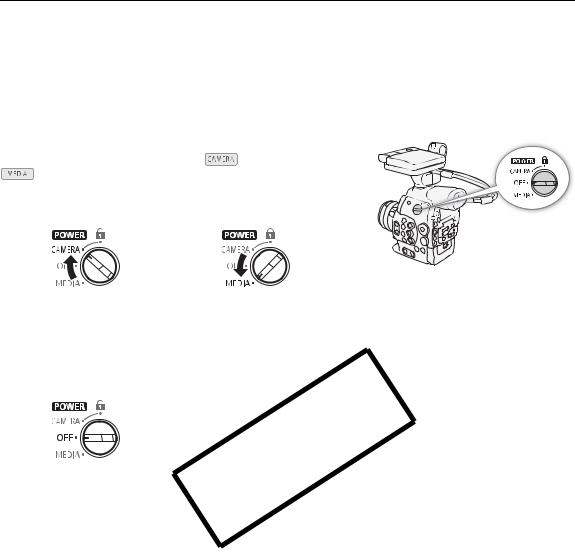
Preparing the Power Supply
Turning the Camera On and Off
The camera has two operating modes: CAMERA ( ) mode for making recordings and MEDIA (
) mode for making recordings and MEDIA ( ) mode for playing back recordings. Select the operating mode using the Qswitch.
) mode for playing back recordings. Select the operating mode using the Qswitch.
28 To turn on the camera |
|
|
|
Set the Qswitch to CAMERA for |
mode or MEDIA for |
|
mode. |
|
• If a message appears prompting you to open the MON./3G-SDI terminal cover, open the cover to shoot in 4K or 2K mode.
CAMERA mode |
MEDIA mode: Allows you to play |
|
back recordings made on a CF card. |
To turn off the camera
Set the Qswitch to OFF.
COPY
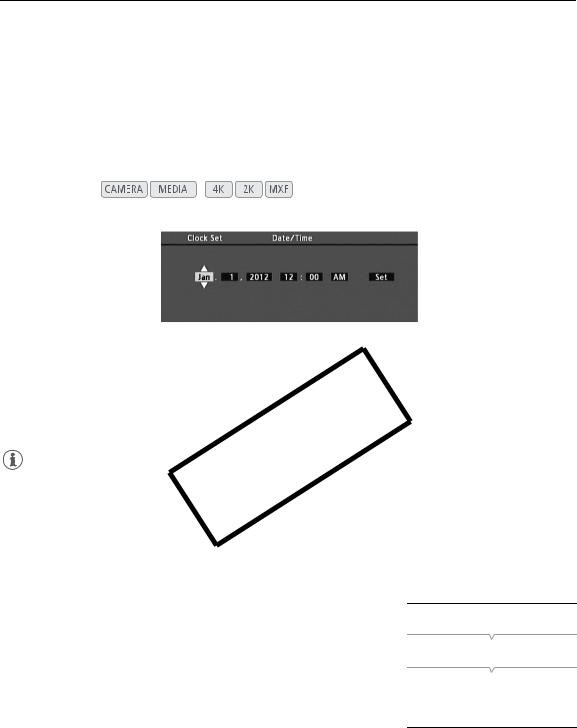
Date, Time and Language Settings
Date, Time and Language Settings |
|
|||
Setting the Date and Time |
|
|||
You will need to set the date and time of the camera before you can start using it. When the camera’s clock is |
29 |
|||
not set, the [Date/Time] screen will appear automatically with the first field selected (month or day, depending on |
||||
|
||||
the country/region of purchase). |
|
|||
Operating modes: |
|
|
|
|
|
|
|||
|
|
|
|
|
1Push the joystick up/down or turn the SELECT dial to change the month/day then move (Ð) to the next field.
• To move to the next field you can also press SET (press the joystick itself or press the SET button).
•You can change the date format andCOPYthe clock format (12/24 hours) with the [wOther Functions] >[Set Clock] >[Date Format] setting.
•You can also change the date and time later on (not during the initial setup) with the [wOther Functions] > [Set Clock] >[Date/Time] setting.
•When the built-in rechargeable lithium battery is exhausted, the date and time setting may be lost. In such case, recharge the built-in lithium battery (A193) and set the time zone, date and time again.
Changing the Time Zone
Change the time zone to match the time zone of your location. The default setting is [UTC-05:00 New York] or [UTC+01:00 Central Europe], depending on the country/region of purchase. The time zones are based on Coordinated Universal Time (UTC).
Operating modes: 





1 Press the MENU button.
2 Push the joystick up/down or turn the SELECT dial to select [wOther Functions].
3 Select [Time Zone] in a similar fashion.
4 Push the joystick up/down or turn the SELECT dial to change the time zone.
5 Press SET to set the time zone and then press the MENU button to close the menu.
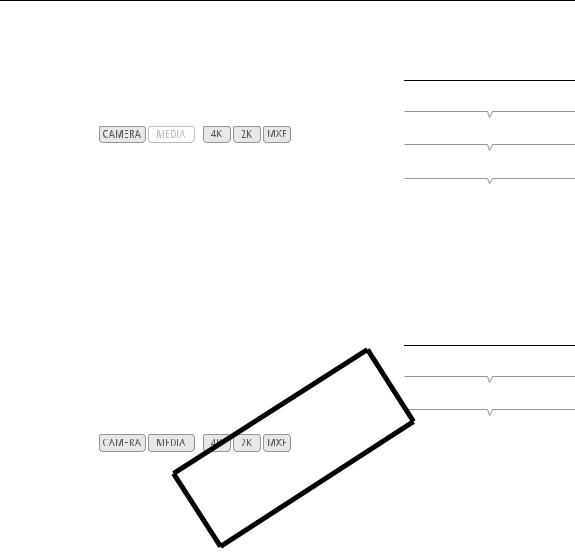
Date, Time and Language Settings
Displaying the Date and Time while Recording
[£LCD/VF Setup]
|
You can display the date and time on the screen. |
|
||||
30 Operating modes: |
|
|
[Custom Display 2] |
|||
|
|
|||||
|
|
[Date/Time] |
||||
|
||||||
|
1 |
Press the MENU button. |
||||
|
||||||
2 |
Push the joystick up/down or turn the SELECT dial to select |
[Off] |
||||
|
|
[£LCD/VF Setup]. |
||||
|
|
|
||||
3 |
Select [Custom Display 2] and then [Date/Time] in a similar fashion. |
|
||||
4 |
Push the joystick up/down or turn the SELECT dial to select the information to display. |
|||||
• Select [Off] to record without displaying the date and time.
5 Press SET and then press the MENU button to close the menu.
• The selected date/time display will appear at the bottom of the screen.
Changing the Language
The default language of the camera is English. You can change it to
German, Spanish, French, Italian, Polish, Russian, Simplified Chinese, |
[Language !] |
|||||
Korean or Japanese. Please note that some settings and screens will be |
||||||
|
||||||
displayed in English, regardless of the language setting. |
[English] |
|||||
|
|
|
|
|
||
Operating modes: |
|
|
|
|
||
|
|
|
|
|||
|
|
|
|
|||
1 |
Press the MENU button. |
|
|
|
|
|
2 |
Push the joystick up/down or turn the SELE T dial to select [wOther Functions]. |
|||||
3 |
Select [Language !] in a similar fashion. |
|
||||
4 |
Push the joystick up/down or turn the SELECT dial to select a language. |
|
||||
5 |
|
COPY |
|
|||
Press SET to change the language and then press the MENU button to close the menu. |
||||||
